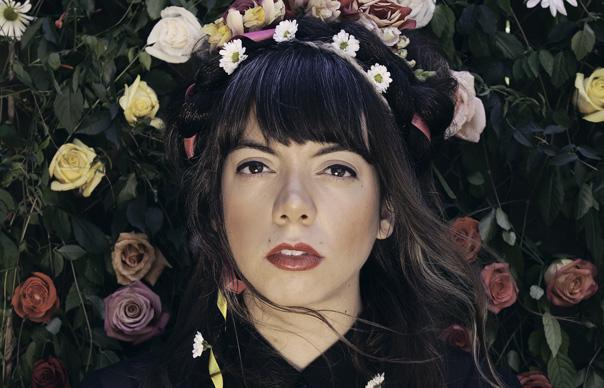Alynda Lee Segarra has the temperament of a wanderer, but she has been embedded in the culture of New Orleans for the best part of a decade and, just back from a month on tour, she is plainly glad to be home. She has returned a star, of sorts. After years of low-key preparation, the first half of 2014 saw a dramatic spike in Hurray For The Riff Raff’s fortunes. Small Town Heroes has been by some distance their most feted record, with the calm, tender authority of Segarra’s voice and songs eliciting comparisons with Gillian Welch. A couple of days ago, the band made their network TV debut on Conan O’Brien’s chat show. Tonight, they will support Charles Bradley in a rowdy French Quarter club with bordello styling. Tomorrow’s agenda involves an afternoon slot at the city’s massive annual Jazzfest, and a headline show, supported by hill country gospel singers, in a Presbyterian Church.
This afternoon, though, the 27-year-old Segarra is pondering whether to order something called a Green Eggs’n’Ham Sandwich, and trying to regain her bearings. She is sat in the back room of her manager Andy Bizer’s offices in the Bywater district: a space that incorporates Bizer’s legal practice, the Hurray For The Riff Raff nerve centre, and his wife’s art studio. Across Segarra’s knuckles, tattoos spell out the word “Songbird”, dating from her late teens and a time when she barely considered herself a singer, let alone a songwriter: “It was like I was making a self-prophecy,” she suggests. Her latest piece of body art depicts a matchbook. “This is my Bob Dylan tattoo,” she says. “‘Strike another match, go start anew…’”
Segarra got her first tattoo at her seventeenth birthday party in New York; a drawing of Frida Kahlo on her arm, with the title of her favourite Kahlo painting, ‘The broken column rebuilds itself’, written alongside in Spanish. The next day, she left town. “I had this incredible urge to get the fuck out. I’d known travellers forever and I was living part time at this squat in Brooklyn [Jon Flee was another resident]. I wasn’t going to school anymore and my aunt was obviously extremely worried about me. New York was so expensive and I just kept thinking, ‘I’ll never survive here.’ My mother seemed to be such a great professional person, but I didn’t really know how to ever emulate that.”
Her mother, Ninfa Segarra, had spent the ‘90s as Deputy Mayor of New York City in Rudolf Giuliani’s administration. “She grew up in the projects in the Lower East Side and, especially as a Puerto Rican woman, she was such a trailblazer. There are definitely things I learned from her but, as a child, I wasn’t necessarily interested in learning those things.”
Alynda Lee actually spent the vast majority of her childhood living with her aunt in the Bronx projects, daydreaming about the vast empty spaces of Kansas and Montana. It was an unlikely fantasy for a misfit of Puerto Rican descent, hating school, victimised by classmates, and obsessed with Marilyn Manson. Manson led to the Dead Kennedys and Bikini Kill and, by her early teens, Segarra was hanging out among the punks in New York’s East Village, petrifying her aunt – though not, as her family suspected, becoming involved with drugs: “I tried smoking weed when I was around 13 or 14 and it terrified me. I was always the kid who was trying to prove that I wasn’t scared of anything, but I felt – and still do feel – like my mind was already overactive enough. I never wanted to lose control – I was trying to gain more and more control.”
She was, in fact, making connections with an underground network of travellers who combined a DIY punk ethos with a Woody Guthrie fantasy of hitching rides on freight trains across America. When she left New York at 17, a better sense of her own identity started to crystallise as she headed west to San Francisco and then, slowly, south towards New Orleans. “I was able to find the punk rockers and that felt like a step,” she says, “and then I was able to find the travellers and that felt like a step, and then I met the people that put all that together for me and were honest and queer and feminist. That’s when I felt like, well, I’m really with my people now.”
Segarra identifies as queer herself – “I’m somebody who feels like my gender doesn’t fit into this very solid idea of feminine and masculine” – and currently leads a band that joyfully debunks the idea of roots music being somewhat reactionary; a band as disdainful of old ideologies as they are respectful of old aesthetics.
“I just want to play with people that I feel a soul connection and a musical connection with,” she continues. “And that soul connection means you have to be a very open-minded person who understands this feminist and queer idea of what we’d like the world to be.”
“When people see us for the first time, most straight people probably don’t immediately think we’re a queer band,” says Yosi Perlstein, the transgender violinist and drummer who emerged out of the travelling community to become Segarra’s right-hand man in 2009. “I’m guessing over time they realise, ‘Oh, they’re actually really political and queer,’ and then we’re able to subversively say, ‘See? It’s OK, we can do this too!’ That’s my hope.”



